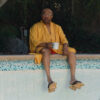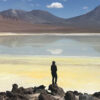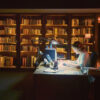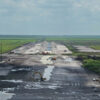Fifteen years ago, Rodney Evans was en route to SXSW with his narrative feature debut “Brother to Brother,” fresh off winning a Special Jury Prize at Sundance. But what was intended to be a victory lap ended up with the filmmaker simply returning home to New York.
“Unfortunately, I missed my connecting flight and actually would’ve gotten there after the Q & A ended, so I ended up just turning around and going back to the artists’ residency that I was at,” recalls Evans. “Missing the whole SXSW experience makes it even doubly special [to premiere a new film there] because I’ve been waiting to go since then.”
“Vision Portraits,” Evans’ first feature in six years, is special for many reasons, not least of which being that there was a time he might’ve thought he’d be incapable of ever making another film. Diagnosed with a rare degenerative eye disease retinitis pigmentosa, Evans was inspired to profile other artists who have lost their sight and reconfigured their artistic process, turning their disability into a strength by channeling what’s in their mind rather than be distracted by what reality presents them with. The filmmaker meets up with John Dugdale, a photographer who has carried on composing shots for 25 years since losing his sight in 1994, Kayla Hamilton, a dancer who believes her performances become stronger when her eyes are closed anyway, and Ryan Knighton, a writer who learns to embrace his new point of view to observe things that others can’t.
As the trio describe how they’ve shifted their focus in ways both ocular and creatively, Evans undergoes treatments as he begins to adjust to a new way of life himself and besides vividly articulating his experience through a number of aesthetically arresting sequences throughout the film, he takes this new obstacle in stride as part of a journey where he’s already had to overcome so much to assert himself as a gay, African-American filmmaker. “Vision Portraits” is extraordinarily moving in its suggestion that much can be gained when our identity is no longer tied to the corporeal form we take and Evans creates a truly transcendent, out-of-body experience that is quite affecting. On his way to Austin, the filmmaker spoke about how his condition has only reemphasized his core attitude towards directing and how he came to the decision to include his own story in the film when it could have professional ramifications, as well as finding his subjects and illustrating what he sees now.
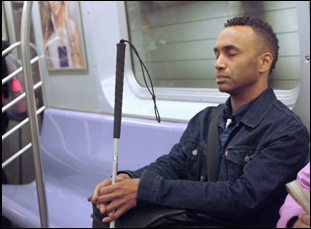
I was always a part of it. I thought I would probably just be a framing device where I just talked about why I wanted to go on this journey to meet these specific artists and maybe came back at the end, but then I did a six-week summer intensive lab at Union Docs and the other participants and instructors really were pushing me to put more of myself into it. It was very clear that I was having very specific trusted conversations with the other artists in the film and coming from a very particular perspective, so I started to experiment a little bit with voiceover and figure out what style of voiceover I wanted to have throughout the film. That was actually the hardest part of editing the film was balancing how I would be a character with the rest of the stories, so I take my hat off to my co-editor Hannah Buck, who is just a master of structure, and I really was able to have my parts be in conversation with the other artists in the film.
You had previously done a short, “Persistence of Vision,” on John Dugdale – were you already thinking about a feature at that time or did the response encourage you to pursue something larger?
I had done that as part of the feature. I teach at Swathmore College, so I’m usually pretty focused on my students during the school year and then during the summer, I usually go away to an artists’ residency program and throughout the making of this film, I would usually tackle one artist at each residency program. I started with John and I just liked the way that that played on its own, so I just decided to send that out on its own while I kept working on the feature-length project and I knew it would get reconfigured as it got reincorporated into the feature.
[Initially with] John’s segment, I really didn’t think I was going to be a part of that chapter at all, but it became much more of a conversation and we had to use whatever small segments of me that happened to get captured on camera asking John questions [during the edit], so that became part of the language of the film where in the short, it really wasn’t. It was really John telling his own story, so even the section where we talk about closing your eyes and the screen goes black and he just says a different succession of images like “A glass of water, an open book, your mother, your father…a tree,” and then asks you while you were closing your eyes if there was anything you didn’t see and then I answer “No” – that segment Hannah, the editor, added because it just became more in sync with the overall language of the film, so it became more important for me to figure out how to be in conversations with the characters within their chapters more and then the gradual evolution of the film into more of a portrait of myself towards the end.I see the film as divided into these chapters, but chapters that are in conversation with each other through these interstitial moments where I’m reflecting on what I heard through each artist and how that is impacting my experience. Ryan and I just had a more natural camaraderie onscreen, even though that was shot at a point where I didn’t think I was going to be on camera – it was impossible for the cinematographer to just shoot Ryan and not have me on the edge of a frame because those were very much back and forth conversations because we were friends, so being more of a part of his segment led more organically into my own chapter.
Did you actually know each of these artists before shooting or did you actually go out looking for them?
[All the artists] came to the project in different ways. I had read [Ryan’s] memoir called “Cockeyed,” which is fantastic and it’s basically about him as an 18-year-old punk rock teenager who gets diagnosed with Retinitis Pigmantosa, which is the same condition that I have. Funny enough, I had submitted to the Sundance Screenwriting Lab and I think got to the second round [that year], but then I saw that Ryan had done a screenplay version of his memoir that was going to the screenwriting lab, so I reached out to Michelle Satter, the artistic director of the Sundance Labs, and asked if there was a director attached to the project. She said no and I let her know that I had the same condition and was interested in meeting Ryan. It was 2008 and we met when he was in New York and we just got along really well. We felt like we were friends forever and whenever he would come to New York, we would hang out, so when this project came up, I called him up and just asked him if he wanted to be involved. He was all in immediately and had tons of ideas about things to potentially incorporate, so he was really helpful in terms of research. [With] John, I always knew his photography and just thought it was stunningly beautiful. It turns out that my brother’s best friend Darrell dated John for 10 years, so John was one degree away. [laughs] And he ended up connecting us. I spent the afternoon with him, showing him my work and so he decided to be a part of the project and then Kayla, I didn’t really have a connection to, but I just knew that I wanted a dancer to be a part of the film and I knew I wanted a woman to be a part of the film, frankly. So I just started brainstorming with a colleague at Swathmore and he had mentioned Kayla, so we had breakfast and just immediately clicked. It just so happened that she was in the final stages of working on this performance [“Nearly Sighted”] that she had been putting together for three years and it was about to premiere at BAAD in the Bronx. So I said, “Are you okay if we come film you in rehearsal and film you in the performances and do an interview after that?” And five days later, we were shooting with her.Oh my gosh. Did you have to mobilize quickly?
No, it was fantastic. I feel with documentary, you can’t really plan too much, which is a nice counterbalance to the fiction world where I feel everything has to be planned to the T before you start a project. When an opportunity presents itself, you just have to go there and it just felt like the stars had aligned for Kayla and myself and Kjerstin [Rossi], the cinematographer that I worked with. Kayla was just really accommodating and completely unguarded and open about her process. Frankly, [being thrown into shooting] made the scenes stronger because she was just not self-conscious. She was really immersed in creating her dance piece, so the cameras floating around was the least of her concerns. She was opening on Friday. [laughs] That was front and center, so it was great to be a fly on the wall.
John makes this great observation in the film about letting go of ego and giving up more control of what happens with the camera when his vision deteriorates while retaining control over the idea of the image – was that easier for you to do in a collaborative medium such as film or a challenge?
Yeah, the whole film is about broadening the definition of what vision is from this ocular process to a very complicated process that involves obviously the mind and the imagination and the visual gathering of information, [as well as] the way the optic nerve sends that information to the brain. All of us have so much visual information stored within our bodies from our decades of existence and [this film shows] how that can be a creative archive to draw on as you’re making work. John articulates that really beautifully in the film, and that helped me realize that I could continue making films without having perfect vision. I could still utilize my imagination and my ideas and shape stories and work with cinematographers to fine-tune the actual look of the film, but I was much more willing to let that go in exchange for focusing more on the storytelling aspects and the power of the emotion that I was getting from the different characters. To be honest, that’s always been my focus in my films.
I feel like I’ve always been an “actor’s director” [because] that’s the one thing that no one else on set is responsible for – the cinematographer has to make sure that the shot is in focus and the [camera] move is being executed in the way we talked about and of course, you’re looking through monitors and have a full grasp of the frame and composition. But then even when I would be shooting, I would be standing next to the actors and focusing on what was going on between them on an emotional level and how that fit into the larger film. It was never about a fixation on the shot composition. I was always in it with the actors to make sure the emotions of a scene were there and if the performances suck or [in documentary] I’m not getting to a certain level of information or emotion when I’m doing an interview, I’m just scratching the surface, right? When there’s more there, I’m not doing my job as a director, so I [always] tended to focus on the duties of directing.
Was it difficult to visually articulate what you see in some of the more abstract sequences of the film?
That was more of an experimental process between myself and the cinematographer, and a lot of it was based on different statements that were made during the interviews. An example would be John talking about his sight as the aurora borealis and getting these flashes of color and light in his optic nerve, constantly firing, but not having anywhere to go. And I knew I had this footage of when the end of a film is basically rolling off of its core and you’re shooting the last remnants off of a 400-foot reel – there tends to be a lot of light and flare happening there, so I just used that color stock and slowed it down and layered it to visualize the ways that John was talking about some of the visual stimulation that he receives in his daily life. People tend to think of blindness as one thing as opposed to gradations along a spectrum, having some minimal vision left or whatever it is – flashes of light, a little bit of color, maybe silhouettes that are moving – so all of those things became information for us to create some of the more abstract visual ideas and put the viewer in the perspective of the subjects.
When Kayla talks about waking up and basically not being able to see anything on the television or her way around the city and just using muscle memory, a lot of [depicting that] was breaking things and refracting light through different objects and moving things in front of the camera so that light would become more abstracted and less realistic in the ways in which her vision had deteriorated for that period of time. She was struggling to just make it from point A to point B, so we thought it was really important for the audience to sit and experience that.
What’s it like putting this out there?
I’m excited to have it finally be done. I’ve been working on it for four-and-a-half years, so I think it’s time for it to be out in the world, being seen because a film doesn’t really mean anything if nobody really sees it. It’s always a little scary when you do something more personal and revealing, but part of my process is just confronting fear and looking at things I fear fairly directly and grappling with them. All of my films have done that – from “Brother to Brother” and coming out in a hostile environment and what does it mean to be a teenager who’s thrown out of your house for being gay and what kind of alternative families do you form to be able to survive, and in “The Happy Sad,” dealing with open relationships and the complexities of those to dealing with blindness and how one continues to create art when one’s vision deteriorates [in “Vision Portraits”]. So it’s a constant process, and it’s a process that continues after the film – all of us have fluctuating states of vision. Kayla’s going to see her glaucoma doctor today. It’s not a stable, static thing, and life is going to continue on after the film, but I’m excited to get this film out there and to continue making films.
“Vision Portraits” will screen at SXSW on March 9th at 2:45 pm at the Alamo Ritz 1, March 10th at 11:45 am at the Alamo Lamar D and March 13th at 9:30 pm at the Alamo Lamar B.
